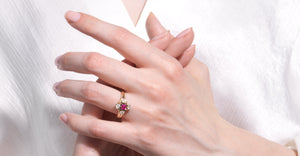Ruby Rings - The Definitive Guide
Jun 29, 2024
by Suzanne Sachs • 5 min read
THE BASICS ---
No gemstone better signifies the blazing heat of summer than the bold and luxurious ruby, the official birthstone of July. This stone is more than just a stunning shade of red or a hot choice for jewelry, however, and learning more about rubies can help you appreciate just how distinctive and beautiful these jewels are. The deeper you delve into the captivating world of this gemstone, the more irresistibly drawn you become to wearing it daily, making it a timeless and versatile choice for any occasion.
WHAT YOU NEED TO KNOW--
In this guide we will explain the following:
- About Rubies
- Factors to Consider When Choosing a Ruby Ring
- Color
- Healing Properties
- Clarity
- Structure
- Mines
- Meaning
- History
- Celebrity
- Ruby Jewelry
- Choosing a Ruby Ring
About Rubies
Rubies are a form of the natural mineral corundum, or aluminum oxide, that has been colored red by chromium in its crystal lattice structure. Other colors of chromium, including blue, orange, yellow, green and black, are sapphires, but the red shade is reserved for rubies. The intensity of the color ranges from lighter red that is nearly pink to a deep, dark red, though the darker shades are considered more valuable.
Different tones can also occur in ruby colors, giving the stones tinges of brown, orange or purple, with purplish hues being the most desirable. Ruby is often confused with other red stones, however, such as garnet, tourmaline and red spinel. Older stones, in particular, may be misidentified as rubies, and it is important to have the stones carefully inspected to ensure their authenticity.
In addition to its bold color, ruby also has a natural fluorescence caused by the chromium in its structure, giving it a rich glow when exposed to ultraviolet light. Because UV light is a natural part of the spectrum, all rubies will glow to some extent, depending on the intensity of the light.
Factors to Consider When Choosing a Ruby Ring
Color
The color of a ruby is its most important quality and significantly impacts its value. The finest rubies display a vibrant red hue known as "pigeon's blood," which is a deep red with a hint of blue. A ruby's color is assessed based on hue, tone, and saturation, with the ideal stones having a pure red hue, medium to medium-dark tone, and high saturation. While most rubies undergo heat treatment to enhance their color and clarity, untreated rubies with excellent natural color are rare and highly prized.
Healing Properties
Rubies are said to have many strong spiritual properties and can enhance passion, energy, confidence and courage. Rubies are believed to bring good fortune and prosperity, and are even believed to have healing properties associated with improved blood circulation. The glow of a ruby mimics the fiery passion of love, and these stones are often associated with romance. In some Asian cultures, placing rubies under the foundation of a new building is believed to bring prosperity, good fortune and protection to that structure.
Clarity
Rubies are subject to a variety of cracks, inclusions and fissures in the crystal structure, which makes it more challenging to find larger, gem-quality natural rubies. Some inclusions, however, create a cat’s eye or starburst effect in the stone, which can enhance its beauty and value when properly cut and displayed to its full advantage.
Structure
Rubies belong to the corundum family and have a hexagonal (trigonal) crystal structure. This crystalline structure contributes to their hardness and durability, ranking 9 on the Mohs scale, making them second only to diamonds.
Mines
Ruby mines are primarily located in Myanmar (formerly Burma), which is renowned for producing the finest and most valuable rubies known as "pigeon's blood" rubies. Other significant ruby sources include Thailand, known for its darker rubies; Sri Lanka, offering lighter, pinkish rubies; and Mozambique, which has become a major supplier in recent years with its vibrant red stones.
Meaning
Rubies have long been associated with love, passion, and romance. Their vibrant red color symbolizes intense emotions and deep affection, making them a popular choice for engagement rings and romantic gifts. Throughout history, rubies have been considered talismans of protection and prosperity. They were believed to guard against misfortune, protect warriors in battle, and bring wealth and success to those who possess them.
In addition to being the official birthstone of July, rubies are also the symbolic gemstone associated with both the fifteenth and fortieth wedding anniversaries.
History
Because rubies are widely available, they have been used in jewelry and ornamentation for thousands of years. During the Victorian era, rubies were highly prized and often featured in romantic and elaborate jewelry designs. The deep red color of rubies symbolized love and passion, making them a popular choice for engagement rings and sentimental pieces. In the Art Deco era, rubies continued to be a favored gemstone but were used in a distinctly different style compared to the Victorian period. The Art Deco movement was characterized by geometric shapes, bold designs, and a fascination with modernity and technology. Rubies were often paired with diamonds and set in platinum, reflecting the era’s preference for clean lines and contrast.
Celebrity
For those who love the glamour of Hollywood and the movies, you can enjoy a ruby ring knowing it is a favorite of many celebrities and royalty. This style has adorned the fingers of top names including Elizabeth Taylor, Sarah Jessica Parker, and Victoria Beckham.
Ruby Jewelry
Because rubies have exceptional hardness – the only naturally occurring gemstones that are harder are diamond and moissanite – they can easily withstand the rigors of daily wear in all types of jewelry. Rubies are found in rings, earrings, bracelets, pendants, brooches and other pieces, both as the center stones and focal points of jewelry designs as well as accent stones. Because of their dominating richness, rubies are not often paired with other colored gemstones, but they are frequently found with diamonds to enhance their sparkle and draw the eye to their distinctiveness.
Choosing a Ruby Ring
Regardless of what you’re celebrating, what type of jewelry you prefer or what your personal vintage style may be, rubies can make a striking statement not just in July, but all year long. Check out our collection of ruby rings and other ruby jewelry, or consider choosing a loose ruby to design the perfect piece with this amazing July birthstone!
Suzanne Sachs
Suzanne has always believed vintage rings can change lives. She's been in the jewelry industry for over 35 years, working with vintage jewelers, diamond dealers, diamond cutters, and gemologists. Suzanne started Artdecodiamonds in 2000 and understood the demand for vintage rings throughout the world. She ultimately started VintageDiamondRing.com in 2014, and understands each vintage ring is a reflection of you – your history, your relationships, your style, your elegance and is honored to have the opportunity to help you showcase your flair in a unique and exquisite way.
Press Love:






